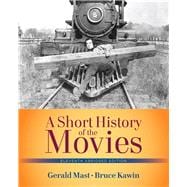
Note: Supplemental materials are not guaranteed with Rental or Used book purchases.
Purchase Benefits
What is included with this book?
1. Introductory Assumptions.
2. Birth.
Frames per second.
Pictures on Film.
Speed.
Flicker and the Continuous Signal.
Persistence of Vision and Other Phenomena.
Seeing with the Brain.
Visual Masking and Retinal Retention.
Scientific Toys.
Émile Reynaud.
Photography.
Muybridge and Marey.
Thomas Edison.
W. K–L. Dickson and William Heise.
Early Cameras and Films.
The Kinetoscope.
A Sound Film and Studio.
Projection.
The Magic Lantern.
The Loop and Other Solutions.
The Lumière Brothers.
R.W. Paul.
The Vitascope.
The First Films.
3. Film Narrative, Commercial Expansion.
Early Companies.
Narrative.
George Méliès.
Cohl and Others.
Edwin S. Porter.
From Brighton to Biograph.
Complexity in Early Film
Business Wars.
The Film d’Art.
4. Griffith.
Apprenticeship.
Biograph: The One-Reelers.
Two Reels and Up.
The Birth of a Nation.
Intolerance.
1917-31.
Broken Blossoms and Way Down East.
The Struggle.
5. Mack Sennett and the Chaplin Shorts.
Krazy Keystones.
Charlie.
6. Movie Czars and Movie Stars.
Stars over Hollywood.
The First Stars.
California, Here We Come.
The Emperors and Their Rule.
Major Studios.
Movie Palaces.
Morality.
Films and Filmmakers, 1910-28.
Thomas Ince.
Douglas Fairbanks.
DeMille and von Stroheim.
Greed.
Henry King.
Oscar Micheaux and the Race Movie.
Webber and Watson.
Weber and Women.
King Vidor.
Lubitsch and Others.
Flaherty and the Silent Documentary.
The Comics.
Laurel and Hardy and Hal Roach.
Harold Lloyd.
Harry Langdon.
Buster Keaton.
The Gold Rush and The General.
Hollywood and the Jazz Age.
Modernism.
Jazz, Booze, and It.
7. The German Golden Age.
Expressionism, Realism, and the Studio Film.
Fantasy.
Caligari.
Metropolis.
Nosferatu.
Psychology.
The Last Laugh.
Pabst and die neue Sachlichkeit.
The End of an Era.
Beyond the Studio.
Exodus to Hollywood.
Using Sound.
Lei Riefenstahl.
8. Soviet Montage.
The Kuleshov Workshop.
Sergei M. Eisenstein.
Battleship Potemkin.
October.
Sound and Color.
Mother.
Later Works.
Other Major Figures.
Alexander Dovzhenko.
Dziga Vertov.
Socialist Realism.
9. Sound.
Processes.
Problems.
Solutions.
10. France between the Wars.
Surrealism and Other Movements.
Gance and Dreyer.
Abel Gance.
The Passion of Joan of Arc.
Rene Clair.
Jean Renoir.
Grand Illusion.
The Rules of the Game.
Vigo and Others.
Jean Vigo.
Carné and Prévert.
11. The American Studio Years: 1930-45.
Film Cycles and Cinematic Conventions.
The Production Code.
Cycles.
Studios and Style.
Women in the Studio Era
The Comics.
Late Chaplin.
Disney’s World.
Lubitsch and Sound.
Frank Capra.
Preston Sturges.
George Cukor.
The Marx Brothers.
Mae West.
W.C. Fields.
Masters of Mood and Action.
Josef von Sternberg.
John Ford.
Howard Hawks.
Alfred Hitchcock.
Orson Welles.
12. Hollywood in Transition: 1946-65.
Enemies Within: Freedom of Association and Free Entertainment.
The Hollywood Ten and the Blacklist.
3-D, CinemaScope, Color, and the Tube.
Films in the Transitional Era.
Freedom of Speech, Preminger, and the End of the Blacklist.
Message Pictures: Kazan and Others.
Adaptations and Values: John Huston and Others.
Film Noir and Other Genres.
The Freed Musicals.
Surfaces and Subversion.
Samuel Fuller .
Late Hitchcock.
Nicholas Ray.
Late Ford.
Douglas Sirk.
Finding the Audience.
13. Neorealism, New Wave, and What Followed.
Italian Neorealism.
Roberto Rossellini.
De Sica and Zavattini.
Luchino Visconti.
Romantics and Antiromantics.
Federico Fellini.
Michelangelo Antonioni.
Pasolini and Bertolucci.
Germi, Leone, and Others.
France---Postwar Classicism.
Cocteau and Others.
Max Ophüls.
Robert Bresson.
Tati, Clouzot, and Others.
1959 and After.
The New Wave.
François Truffaut.
Jean-Luc Godard.
Alain Resnais.
Chabrol, Rohmer, and Rivette.
Varda, Marker, and the Documentary.
Malle and Others.
14. National Cinemas: 1945-.
Sweden and Denmark.
Ingmar Bergman.
England.
Postwar Masters.
Another New Wave.
Loach, Leigh, and Others
Central and Eastern Europe.
The Czech Golden Age.
Poland.
Hungary.
The Balkan States.
Asia
Japan.
India.
China.
Taiwan.
Hong Kong.
Korea.
15. Hollywood Renaissance: 1964-76.
American Auteurs.
John Cassavetes.
Woody Allen.
Robert Altman.
Francis Ford Coppola.
Martin Scorsese.
Malick, De Palma, and Others.
Stanley Kubrick.
The Independent American Cinema.
Early History.
Film Poets.
16. National Cinemas 2: 1968-.
Das neue Kino.
Rainer Werner Fassbinder.
Werner Herzog.
Wim Wenders.
Von Trotta and Others.
Third World Cinemas.
Emerging Cinemas, Emerging Concerns.
Instructive Dramas.
Documentaries.
Gutiérrez
Alea and Sembene.
Other English-Language Cinemas.
Australia.
New Zealand.
Canada.
Ireland and Elsewhere.
Russia and the Former Soviet Union.
Paradjanov, Tarkovsky, and Others.
Glassnost and After.
Iran.
The New Internationalism.
Luis Bunuel and Spain.
17. The Return of the Myths: 1977-.
Star Wars and the New Mythology.
Superheroes, Slashers, and Cops.
Myth and Antimyth.
Popular Heroes and Postmodern Irony.
Leading Directors.
Lucas and Spielberg.
David Lynch.
Jim Jarmusch
John Waters
Joel and Ethan Coen
Jonathan Demme
Terry Gilliam
Carl Reiner and Others
Robert Zemeckis.
Tim Burton
Oliver Stone
Quentin Tarantino
Robert Rodriguez
John Sayles
Charles Burnett
Spike Lee
Luis Valdez
Gus Van Sant
Julie Taymor and Others.
Ridley Scott and Others.
Christopher Nolan and Others.
18. Conglomerates and Video: 1975-.
It’s A Wonderful Deal.
Sequels and Blockbusters.
Conglomerates.
For Sale: Studio.
The Budget Explosion.
Executive Decisions.
Theatres.
Studio Shake-ups.
Movies in the Age of Video.
Analog and Digital Information.
Sampling and Conversion.
Videotape Recorders, Cassettes, and Discs.
DVDs.
Out of the Vaults.
Pixels and Lines.
Film and Video Frames.
Changes on the Set.
Nonlinear Editing.
Copies and Originals.
Colorization.
Electronic Cinema.
19. Digital Cinema: 1999-.
Doing without Film.
Beginnings.
Production and Distribution.
The Look of the Future.
Glossary.
Acknowledgments.
Index.
The New copy of this book will include any supplemental materials advertised. Please check the title of the book to determine if it should include any access cards, study guides, lab manuals, CDs, etc.
The Used, Rental and eBook copies of this book are not guaranteed to include any supplemental materials. Typically, only the book itself is included. This is true even if the title states it includes any access cards, study guides, lab manuals, CDs, etc.